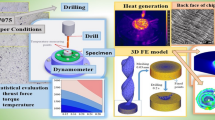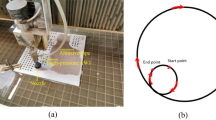Abstract
AA7075 aluminum alloy attracts scientific interest to participate in production of crucial components in aerospace, construction and automotive domains. Specifically, final products need to display equal quality to ensure the basic standards of safety in the aircraft industry. Despite the high machinability of the AA7075 alloy, hole quality may vary according to tool geometry and drilling parameters. In this study, the effects of different feed rate levels and cutting speeds on the surface roughness (Ra) and thrust (Fz) were investigated. Drilling experiments were conducted with drills of three different quality and geometry. The effects of drilling variables on the surface roughness and the thrust force according to “the smaller-the better” approach of the gray relation analysis (GRA) method have been investigated. Consequently, the highest and lowest gray relations degrees obtained were 0.828 and 0.338, respectively. Numerical analyzes for thrust force were performed with the ThirdWave AdvantEdge simulation software based on the finite element method. We also outlined that there exists an average difference of 4.9 % between the experimental and simulation thrust force values, and we proved the applicability of the finite element model.
Similar content being viewed by others
References
Q. Geng and W. Wang, Experimental research on constant-current source ultrasonic strengthening characteristics of 7075-T651 aluminum alloy, Journal of Mechanical Science and Technology, 33(3) (2019) 1203–1209.
ASM Handbook, Machining, ASM International, Printed in USA, 16 (1999) 761–804.
E. S. Puchi-Cabrera, M. H. Staia, E. Ochoa-Pérez, J. G. La Barbera-Sosa, C. Villalobos-Gutierrez and A. Brenlla-Caires, Flow stress and ductility of AA7075-T6 aluminum alloy at low deformation temperatures, Materials Science and Engineering A, 528 (2011) 895–905.
B. J. Griffiths, Surface integrity and functional performance, Manufacturing Surface Technology, Penton Press London (2001).
S. Kalidas, R. E. DeVor and S. G. Kapoor, Experimental investigation of the effect of drill coatings on hole quality under dry and wet drilling conditions, Surface & Coatings Technology (2001) 117–128.
A. Rivero, G. Aramendi, Herranz and L. N. Lopez de Lacella, An experimental investigation of the effect of coatings and cutting parameters on the dry driling performance of aluminum alloys, International Journal of Advanced Manufacturing Technology, 28(1) (2006) 1–11.
E. Kılıçkap, Modeling and optimization of burr height in drilling of Al-7075 using taguchi method and response surface methodology, International Journal of Advanced Manufacturing Technology, 49 (2010) 911–923.
E. Ekici, A. R. Motorcu and G. Uzun, An investigation of the effects of cutting parameters and graphite reinforcement on quality characteristics during the drilling of Al/10B4C composites, Measurement, 95 (2017) 395–404.
J. Kim and D. A. Dornfeld, Development of an analytical model for drilling burr formation in ductile materials, Journal of Engineering Materials and Technology-Transactions of The ASME, 124(2) (2002) 192–198.
M. Günay, M. E. Korkmaz and N. Yaşar, Finite element modeling of tool stresses on ceramic tools in hard turning, Mechanika, 23(3) (2017) 432–440.
Y. Yang and J. Sun, Finite element modelling and simulating of drilling of titanium alloy, 2nd International Conference on Information and Computing Science, Manchester, UK (2009) 21–22.
O. Isbilir and E. Ghassemieh, Finite element analysis of drilling of titanium alloy, Procedia Engineering, 10 (2011) 1877–1882.
R. Muhammad, N. Ahmed, Y. M. Sharif and V Silber-schmidt, 3D finite element modelling of drilling process, 20th IWCMM, Loughborough University, Loughboorough (2010).
M. E. Korkmaz and M. Günay, Finite element modelling of cutting forces and power consumption in turning of AISI 420 martensitic stainless steel, Arabian Journal For Science And Engineering, 43(9) (2018) 4863–4870.
İ. Ucun, 3D finite element modelling of drilling process of Al7075-T6 alloy and experimental validation, Journal of Mechanical Science and Technology, 30(4) (2016) 1843–1850.
A. Gök, K. Gök and M. B. Bilgin, Three-dimensional finite element model of the drilling process used for fixation of Salter-Harris type-3 fractures by using a K-wire, Mechanical Sciences, 6 (2015) 147–154.
M. E. Korkmaz and M. Günay, Identification of constitutive model parameters for nimonic 80A superalloy, Transactions of The Indian Institute of Metals, 71(12) (2018) 2945–2952.
T. Ishida, H. Moriguchi and A. Ikegaya, Development of cemented carbide tool of reduced rare metal usage, Industrial Materials, 73 (2011) 52–56.
S. Li and B. Hou, Material behavior modeling in machining simulation of 7075-T651aluminum alloy, Journal of Engineering Materials and Technology, 136 (2013) 011001.
M. Daoud, W. Jomaa, J. Chatelain and A. Bouzid, A machining-based methodology to identify material constitutive law for finite element simulation, International Journal of Advanced Manufacturing Technology, 77 (2015) 2019–2033.
Z. A. Khan, A. N. Siddiquee and S. Kamaruddin, Optimization of in-feed centreless cylindrical grinding process parameters using grey relational analysis, Pertanika Journal of Science and Technology, 20(2) (2012) 257–268.
R. S. Pawade and S. S. Joshi, Multi-objective optimization of surface roughness and cutting forces in high-speed turning of inconel 718 using taguchi grey relational analysis (TGRA), International Journal Of Advanced Manufacturing Technology, 56 (2011) 47–62.
J. P. Davim, Machining Fundamentals and Recent Advances, Springer (2008) 167–190.
İ. Çiftçi, The influence of cutting tool coating and cutting speed on cutting forces and surface roughness in machining of austenitic stainless steels, Journal of the Faculty of Engineering and Architecture of Gazi University, 20(2) (2005) 205–209.
N. Yaşar, M. Boy and M. Günay, The effect of drilling parameters for surface roughness in drilling of AA7075 alloy, Matec Web of Conferances, 112 (2017).
N. Yaşar and M. Günay, The influences of varying feed rate on hole quality and force in drilling cfrp composite, GU J. Sci., 30(3) (2017) 39–50.
T. Özel, The influence of friction models on finite element simulations of machining, International Journal of Machine Tools & Manufacture, 46(5) (2006) 518–530.
P. D. Singh and V. Rao, A surface roughness prediction model for hard turning process, International Journal of Advanced Manufacturing Technology, 32 (2007) 1115–1124.
B. Fnides, H. Aouici and M. A. Yallese, Cutting forces and surface roughness in hard turning of hot work steel X38CrMoV5-1 using mixed ceramic, Mechanika, 2 (2008) 73–78.
E. M. Trent, Metal Cutting, Butterworths Press, London (1989).
A. Kalyon, M. Günay and D. Özyürek, Application of grey relational analysis based on Taguchi method for optimizing machining parameters in hard turning of high chrome cast iron, Advances in Manufacturing, 4(6) (2018) 419–429.
Author information
Authors and Affiliations
Corresponding author
Additional information
Recommended by Associate Editor Yongho Jeon
Nafiz Yaşar is an Asst. Prof. Dr. in Karabük University, Karabük, Turkey. He received his Ph.D. in Mechanical Engineering from Karabük University. His research interests include manufacturing, cutting tool technology, finite element method.
Rights and permissions
About this article
Cite this article
Yaşar, N. Thrust force modelling and surface roughness optimization in drilling of AA-7075: FEM and GRA. J Mech Sci Technol 33, 4771–4781 (2019). https://doi.org/10.1007/s12206-019-0918-5
Received:
Revised:
Accepted:
Published:
Issue Date:
DOI: https://doi.org/10.1007/s12206-019-0918-5




